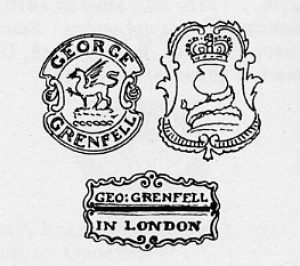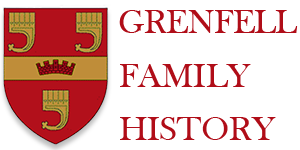George Grenfell (Granville) (1734 - 1784)
 GRENFELL, George (1834-1784), pewterer, was christened in St Mary’s Chapel, Penzance, Cornwall 31 Mar 1734, third son of Pascoe Grenfield, merchant of Penzance by his second wife, Mary, daughter of John Maugham, merchant of Marazion. Pascoe Grenfell (1729-1810) was his brother and Pascoe Grenfell MP (1761-1838), his nephew.
GRENFELL, George (1834-1784), pewterer, was christened in St Mary’s Chapel, Penzance, Cornwall 31 Mar 1734, third son of Pascoe Grenfield, merchant of Penzance by his second wife, Mary, daughter of John Maugham, merchant of Marazion. Pascoe Grenfell (1729-1810) was his brother and Pascoe Grenfell MP (1761-1838), his nephew.
Grenfell moved to London around 1750 where he was apprenticed to pewterer Robert Hitchman; and in 1757 his 7 year apprenticeship having ended he was elected a freeman of the Pewterers Co. Very shortly afterwards in October 1757 his name is to be found among the Penzance Custom House Letter Books as being involved with the London end of Messrs Grenfell & Co., Cannon Street. Further references appear in March/September 1758 as Messrs Geo Grenfell & Co., Gracechurch Street, and lastly on June 21 1759 as Mr Geo Grenfell, Pewterer in London. The latter description was made possible by his election to the livery on 15 March 1759, in which year he employed his only apprentice William Madder, son of Samuel Madder, wine merchant, of Exeter. He was a reluctant participant in the Pewterers & Company and in 1770 he was fined £15 for refusing to accept the office of Steward and again in 1778 he was fined £20 for refusing to accept the position of Renter Warden.
In1764 he had moved to Exeter but his business activities there were not successful and in 1767 he and his associates, who included Samuel Madder, were declared bankrupt. He had returned to London by 1770 and by 1781 had changed his name to Granville. His will dated 29 September 1784 refers to George Granville otherwise George Grenfell and as George Granville of Kentish Town.
The Grenfell family were very much involved in the merchanting and smelting of tin and copper and it is very likely that George’s move to London as a 16-year-old apprentice might have been designed to further the family interests, as much of the Cornish tin at this time was used for the manufacture of pewter. Pewter carrying the Grenfell mark is relatively common, particularly in the USA, which suggests a successful export business. For his touch (mark) he adopted the Grenville/Granville crest On a chapeau gules, turned up ermine, a griffon passant or (above).
The letter books referred to above show that in 1759 he was also acting as the London agent for the family business with his brother Pascoe responsible for the Cornwall end. In the latter half of the 18th century as the pewter industry declined because of changing fashions and the competition from earthenware, it is likely that Granville’s business interests diversified. The success of this can be judged by the fact that in his will he was able to bequeath to his daughter, Charlotte, who married her cousin Pascoe Grenfell (1761 – 1838), the sum of £5,000, which is probably worth around £400,000 at today’s values.

